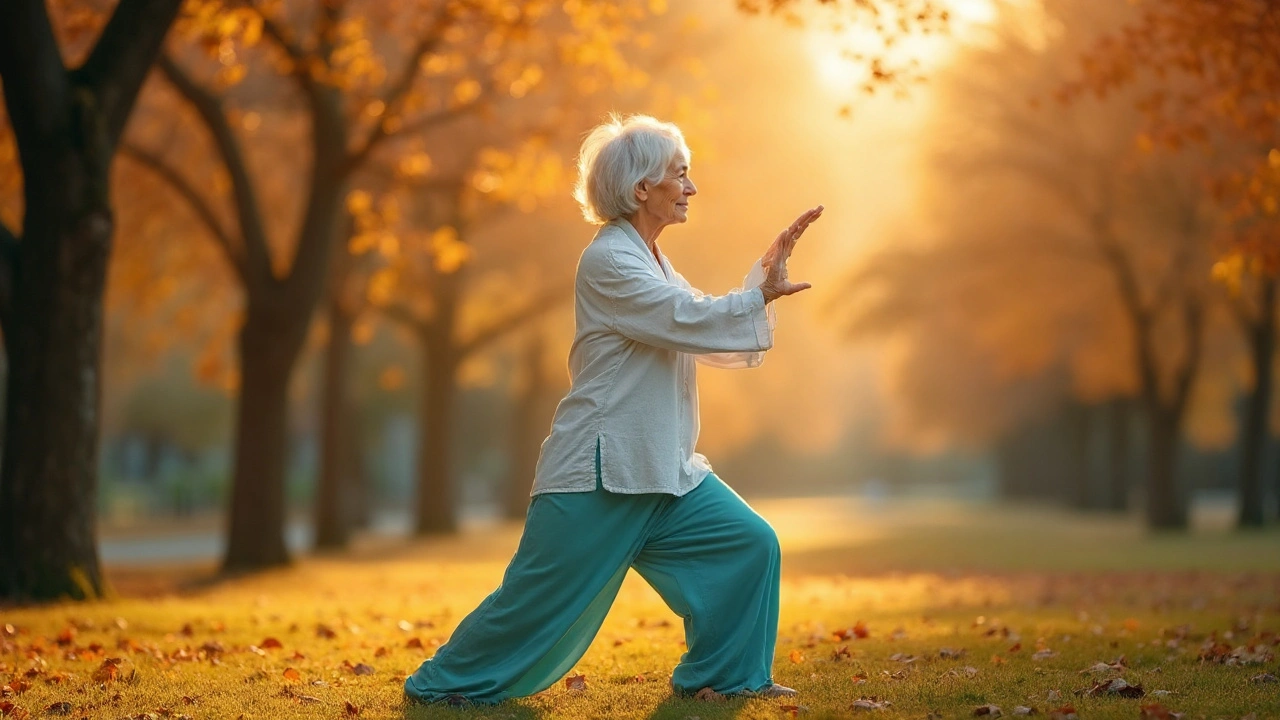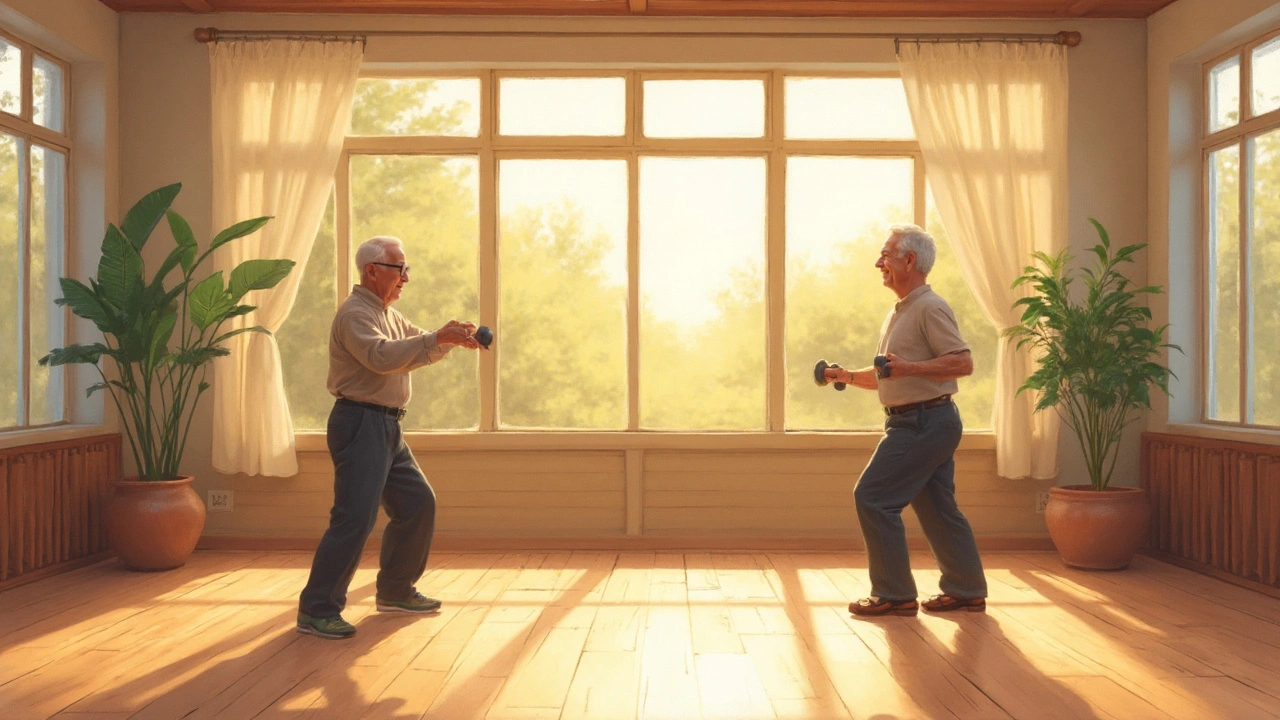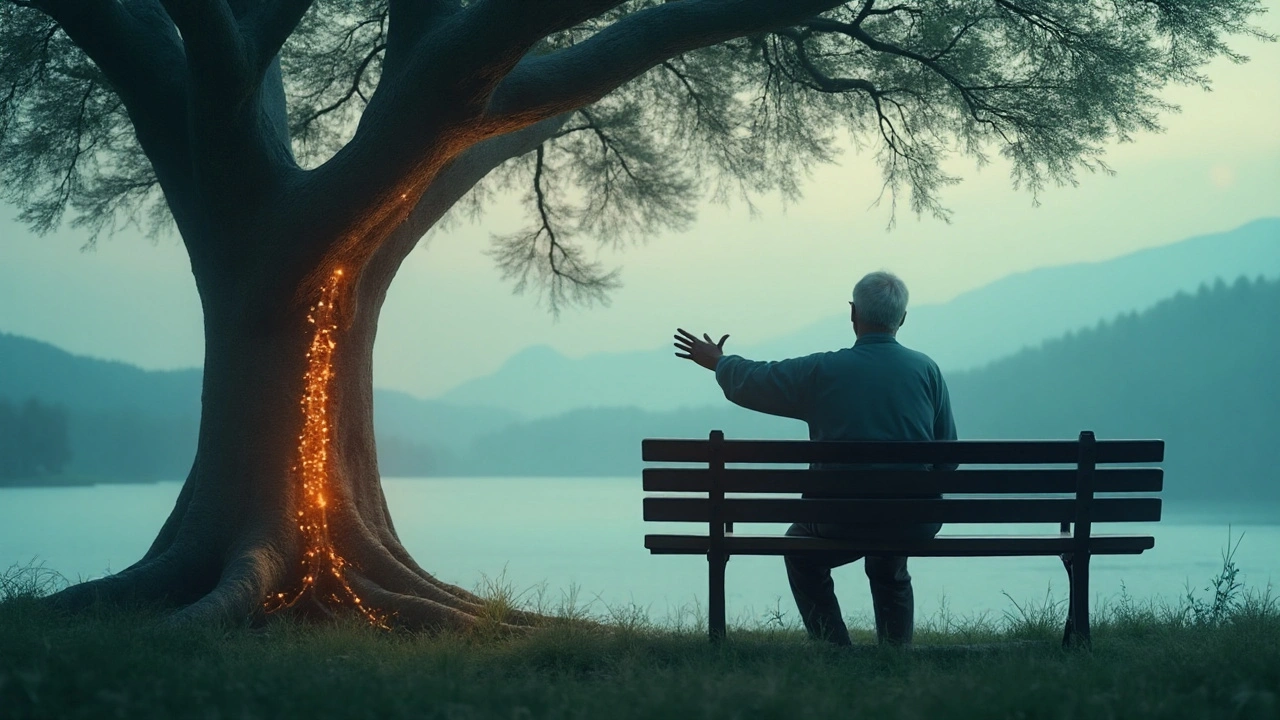How Tai Chi Helps Osteoporosis Patients Boost Bone Health and Prevent Falls

Tai Chi Bone Health & Fall Risk Calculator
Tai Chi may look like a slow dance, but for people with osteoporosis it can be a powerful medicine for stronger bones and fewer falls.
What is Tai Chi and Why It Matters for Bone Health
Tai Chi is a low‑impact, slow‑motion martial art that doubles as a mind‑body exercise, characterized by gentle weight shifts, coordinated breathing, and flowing postures. It originated in China over 300 years ago and has since been studied for its health benefits.
Unlike high‑impact aerobics, Tai Chi stresses the neuromuscular system without jarring the skeleton, making it safe for fragile bones.
Understanding Osteoporosis
Osteoporosis is a chronic condition where bone mineral density (BMD) declines, increasing fracture risk. The World Health Organization (WHO) defines osteoporosis as a BMD T‑score of -2.5 or lower.
Typical complications include vertebral compression fractures, hip fractures, and a steep rise in mortality after a fall.
Key Benefits of Tai Chi for Osteoporosis Patients
- Modest gains in bone mineral density: Randomized trials in Japan and the United States have reported 1‑2% increases in lumbar spine BMD after 12‑month Tai Chi programs (National Osteoporosis Foundation data).
- Improved balance and proprioception: Tai Chi’s weight‑shifting sequence trains the vestibular system and foot‑ankle muscles, cutting fall rates by up to 40% in high‑risk seniors.
- Reduced fear of falling: The meditative component lowers anxiety, which in turn improves gait confidence.
- Cardiovascular and metabolic support: Gentle aerobic activity boosts circulation, enhancing calcium and vitamin D delivery to bone tissue.
- Higher adherence: Because the routine feels like a moving meditation, dropout rates are lower than for traditional resistance training.
How Tai Chi Influences Bone Remodeling
Bone Mineral Density (BMD) measures the amount of mineral matter per cubic centimeter of bone, usually expressed in g/cm².
Mechanical loading triggers osteoblast activity through Wolff’s law. While Tai Chi is low impact, its repeated micro‑loads from shifting weight and controlled stance transitions still stimulate bone cells, especially in the lumbar spine and femoral neck.
Studies using dual‑energy X‑ray absorptiometry (DXA) have shown that participants who practiced Tai Chi three times a week for a year maintained BMD, whereas a control group lost 2‑3%.

Balance, Falls, and the Fear Factor
Balance is the ability to maintain the body's center of gravity over its base of support.
Research from the University of Hong Kong links Tai Chi‑derived balance training to a 30% reduction in the odds of a fall‑related fracture.
Falls are the leading cause of non‑traumatic injuries in people over 65, accounting for 80% of hip fractures.
By improving proprioception and the coordination of ankle‑muscle reflexes, Tai Chi helps the body react faster to trips, preventing the cascade that leads to a fall.
Mind‑Body Synergy: The Role of Meditation
Mind‑body therapy is a technique that integrates mental focus with physical movement to influence physiological processes.
The meditative breathing in Tai Chi lowers cortisol, a hormone that can accelerate bone resorption when chronically elevated. Lower stress also improves sleep quality, further supporting bone repair.
Comparing Tai Chi with Other Osteoporosis‑Friendly Exercises
| Exercise | Impact Level | Balance Improvement | Bone Density Effect | Typical Adherence |
|---|---|---|---|---|
| Tai Chi | Low | High | Modest (1‑2% BMD gain) | 80‑90% over 12 months |
| Walking | Low‑moderate | Medium | Minimal (≤0.5% BMD change) | 70‑80% |
| Resistance Training | Moderate | Low‑medium | Significant (2‑4% BMD gain) | 60‑70% (higher drop‑out due to soreness) |
The table shows why Tai Chi often wins for people who dread high‑impact work yet still want measurable bone benefits.
Practical Tips to Start a Safe Tai Chi Routine
- Get a medical clearance: Confirm with your physician that weight‑bearing activity is appropriate.
- Find a qualified instructor: Look for teachers certified by the International Tai Chi Chuan Association (ITCCA) or local senior‑center programs.
- Start with 20‑minute sessions, three times a week, focusing on the “Eight Forms” sequence.
- Wear supportive footwear with non‑slip soles; avoid hard‑sole shoes that reduce proprioceptive feedback.
- Incorporate calcium‑rich foods (milk, yogurt, leafy greens) and ensure vitamin D levels are above 30ng/mL-both are essential for bone remodeling.
- Track progress: Use a simple log to note session length, perceived balance, and any discomfort.
After eight weeks, reassess balance using the “One‑Leg Stand” test; an improvement of 5‑10 seconds suggests the program is working.
Related Concepts and Next Steps
While Tai Chi is a standout, other mind‑body movements like Qi Gong offer similar breathing techniques with a lighter movement profile.
For those seeking a higher bone‑stimulating stimulus, Weight‑bearing exercise such as stair climbing or low‑impact dancing can complement a Tai Chi routine.
Always pair exercise with adequate nutrition: the National Osteoporosis Foundation recommends 1,200mg of calcium per day for adults over 50, plus 800‑1,000 IU of vitamin D.
Future reading could explore “Tai Chi and Cardiovascular Health,” “Resistance Training Protocols for Osteoporosis,” or “Nutrition Strategies to Maximize Bone Healing.”

Frequently Asked Questions
Can Tai Chi replace medication for osteoporosis?
No. Tai Chi is an adjunct therapy that can improve balance and modestly increase bone density, but it does not replace bisphosphonates, hormone‑replacement therapy, or other doctor‑prescribed medicines. Always discuss exercise plans with your healthcare provider.
How often should I practice Tai Chi to see bone benefits?
Research points to at least three 45‑minute sessions per week for a minimum of six months. Consistency is key; sporadic practice yields little effect on BMD.
Is Tai Chi safe for someone who has already fractured a hip?
Post‑surgical patients should wait until cleared by their surgeon and physiotherapist. Modified, seated Tai Chi forms can be introduced early to maintain mobility without stressing the healing joint.
Do I need special equipment for Tai Chi?
No equipment is required. A flat, non‑slippery surface, comfortable clothing, and supportive shoes are enough. Some classes provide a wooden floor or a mat for extra stability.
Will Tai Chi help with osteoporosis‑related back pain?
Yes. The gentle spinal extensions and core‑strengthening sequences in Tai Chi improve posture and reduce muscular tension, often easing chronic vertebral pain.
How does Tai Chi compare to yoga for bone health?
Both are low‑impact, but Tai Chi places a greater emphasis on weight shifting and dynamic balance, which translates into slightly better outcomes for fall prevention. Yoga offers more static stretching, which can improve flexibility but provides less mechanical loading for bone.
Is there an age limit for starting Tai Chi?
No strict age limit. Programs exist for adults as young as 18 and for seniors over 85. The key is to start with beginner‑level forms and progress at a comfortable pace.
Wendy Chiridza
September 23, 2025 AT 21:59Tai Chi really is the quiet hero of bone health. I started after my mom fractured her wrist and now I do it every morning with her. No fancy gear, no gym membership - just slow movements and breathing. We’ve both noticed we’re steadier on our feet, and I swear my posture’s better too.
It’s not a miracle, but it’s the only thing I’ve stuck with for over a year.
Mark Gallagher
September 24, 2025 AT 08:47Let me be clear - this is pure Chinese propaganda dressed up as science. The U.S. has better options like weightlifting and real physical therapy. This slow dance is for people who don’t want to sweat. Bone density doesn’t improve from ‘flowing postures’ - it improves from LOAD. Period.
And don’t get me started on the ‘meditation’ nonsense. If you want stress relief, go for a run. Not some ancient mystic ritual.
Pamela Mae Ibabao
September 26, 2025 AT 07:21Okay but have you seen the cortisol drop in people who do Tai Chi? I mean, I’m not saying it’s magic - but I’ve worked with seniors who went from terrified of stairs to doing the Eight Forms like they were born to it.
And honestly? The fear of falling is worse than the actual fracture risk. This stuff reprograms your brain. The BMD gains are modest, sure - but the quality-of-life gains? Priceless.
Also, I’ve seen people who quit resistance training because it hurt too much, come back to life with Tai Chi. That’s not fluff. That’s survival.
Gerald Nauschnegg
September 26, 2025 AT 14:01Bro I did Tai Chi for 6 months after my knee surgery and honestly? I’m still doing it. My doc was skeptical too - said ‘it’s just moving slowly’ - but my DXA scan showed I held my BMD while my buddy who did only walking lost 2.3%.
Also, I can now stand on one leg for 32 seconds. I used to fall getting out of the shower. Now I’m teaching my 78-year-old aunt. She calls it ‘dancing with gravity.’
And no, I don’t wear silk pants. I wear sweatpants. Don’t let the aesthetic fool you - this is hard work disguised as calm.
Palanivelu Sivanathan
September 27, 2025 AT 08:17Ohhhhh... the ancient wisdom of the Dragon’s Breath, the whispering winds of the Tao, the silent dance of the earth’s energy flowing through the spine...
Is this not the very essence of harmony between Heaven and Bone? In the East, we do not force, we yield - and in yielding, we become unbreakable.
When the West screams at iron, we breathe into the silence - and the bones, like bamboo, bend without breaking...
Have you felt the Qi? No? Then you have not truly lived...
But I digress...
Also, vitamin D is 800 IU, not 1000, unless you live in a cave...
And yoga? Please. Yoga is for people who want to touch their toes while pretending they’re enlightened. Tai Chi? That’s for people who want to live.
And yes, I have studied under a master in Hangzhou. He was 107. He still does the form. He has no teeth. He has perfect balance.
So. What’s your excuse?
Joanne Rencher
September 27, 2025 AT 16:49Ugh. Another ‘Tai Chi is magic’ article. I’ve seen this same fluff for 15 years. Where’s the big RCT? Where’s the long-term data? It’s all ‘modest gains’ and ‘lower fear’ - which is nice, I guess, but doesn’t fix broken hips.
Also, why is everyone so obsessed with ‘meditation’? Just go do squats. Or walk. Or stop being so fragile.
Erik van Hees
September 28, 2025 AT 09:16Actually, the 1-2% BMD gain is misleading. That’s only in the lumbar spine. The femoral neck? Almost no change. And the studies? Mostly funded by Chinese universities or wellness nonprofits. Where’s the NIH-funded, double-blind, placebo-controlled trial? There isn’t one.
Also, ‘lower cortisol’? That’s true for any relaxing activity - including knitting or listening to jazz. Don’t give Tai Chi credit for being the only thing that reduces stress.
And the adherence rate? Of course people stick with it - it’s easy. No soreness. No sweat. No accountability. That’s not a virtue - it’s a cop-out.
Real bone building requires resistance. Period. End of story.
Cristy Magdalena
September 29, 2025 AT 01:32I started Tai Chi after my husband died. I didn’t think I’d survive the winter. I didn’t want to move. I didn’t want to breathe.
And then one day, I just showed up. The instructor didn’t push me. She just said, ‘Stand here. Breathe.’
Three months later, I stood on one leg for 15 seconds. I cried. Not because I was strong - because I felt like I was still here.
It didn’t fix my osteoporosis. But it gave me back the quiet joy of being in my body.
And if that’s not medicine, I don’t know what is.
Adrianna Alfano
September 29, 2025 AT 03:12OMG I just found a Tai Chi class at my local library and it’s for seniors and it’s FREE and the instructor is this sweet lady from Vietnam who teaches in broken English and I love her so much
and i didn’t know tai chi was actually good for bones like i thought it was just for zen people
and i tried the one leg stand and i fell but then i did it again and held it for 8 seconds and i cried again
also i started eating yogurt every day and my doctor said my vit d is up to 42ng/ml so i feel like a warrior now
thank you for this post i’m gonna bring my mom next week
ps i think yoga is kinda boring but tai chi feels like moving poetry
and i have no idea how to spell proprioception but i know what it means now